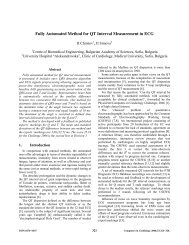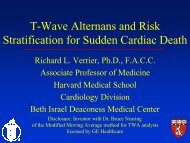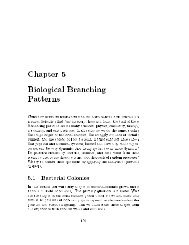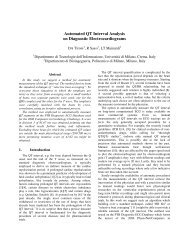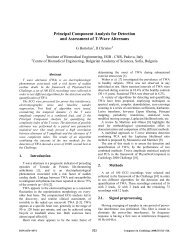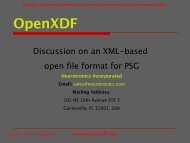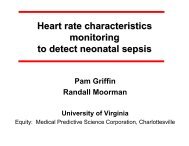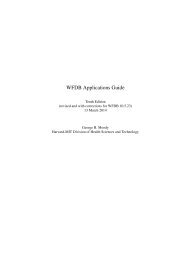An Improved Spectral Method of Detecting and Quantifying T-Wave ...
An Improved Spectral Method of Detecting and Quantifying T-Wave ...
An Improved Spectral Method of Detecting and Quantifying T-Wave ...
You also want an ePaper? Increase the reach of your titles
YUMPU automatically turns print PDFs into web optimized ePapers that Google loves.
<strong>An</strong> <strong>Improved</strong> <strong>Spectral</strong> <strong>Method</strong> <strong>of</strong> <strong>Detecting</strong> <strong>and</strong><br />
<strong>Quantifying</strong> T-<strong>Wave</strong> Alternans for SCD Risk Evaluation<br />
TW Shen, YT Tsao<br />
Tzu Chi University, Hualien, Taiwan<br />
Abstract<br />
T-wave alternans (TWA) is widely understood as an<br />
important indicator <strong>and</strong> a predictor <strong>of</strong> risk <strong>of</strong> sudden<br />
cardiac death (SCD). This research provides an<br />
improved spectral method <strong>of</strong> detecting <strong>and</strong> quantifying T-<br />
<strong>Wave</strong> alternans. Basically, the algorithm used enhanced<br />
TWA spectrum <strong>and</strong> T-Slope variations to generate two<br />
parameters: enhanced alternans ratio (EAR) <strong>and</strong> range<br />
index (RI). Then, the singular value decomposition<br />
method was applied to fuse two parameters. The results<br />
showed that our method has 82.4% accuracy on MIT-<br />
SCD database <strong>and</strong> 76.7% accuracy on normal healthy<br />
individuals. Moreover, the method achieved the 0.636<br />
final score on the <strong>of</strong>ficial PhysioNet Challenge 2008<br />
dataset.<br />
1. Introduction<br />
T-wave alternans (TWA) was first observed by H.E.<br />
Hering [1] at one hundred year ago. Basically, TWA is a<br />
pattern in the ECG characterized by two distinct forms <strong>of</strong><br />
T-waves appearing in alternation. TWA measurements<br />
allow detecting the periodic changes <strong>of</strong> the consecutive<br />
T-wave amplitude at microvolt level [2-4]. Furthermore,<br />
some recently studies showed that TWA is related to<br />
cardiac instability <strong>and</strong> increased arrhythmogenicity [5-6].<br />
Currently, TWA is widely understood as an important<br />
indicator <strong>and</strong> a predictor [7] <strong>of</strong> risk <strong>of</strong> sudden cardiac<br />
death (SCD) which is responsible for an estimation <strong>of</strong><br />
400,000 deaths per year in the United States <strong>and</strong> millions<br />
<strong>of</strong> mortalities worldwide.<br />
SCD is a life threatening event which is result <strong>of</strong> a<br />
precipitous loss <strong>of</strong> heart function. When this occurs, no<br />
blood can be pumped to the rest <strong>of</strong> the body within<br />
minutes in a person with known or unknown cardiac<br />
disease. Only 1-2% <strong>of</strong> patients can survive when SCD<br />
occurs outside <strong>of</strong> a hospital [8]. Fortunately, TWA is<br />
potentially a SCD risk indicator to prevent the possible<br />
loss. In particular, the absence <strong>of</strong> significant TWA in a<br />
patient with congestive heart failure, low ejection fraction,<br />
or a recent myocardial infarction is strongly predictive <strong>of</strong><br />
a low risk <strong>of</strong> SCD.<br />
Hence, many researchers [2-4][6] provided their<br />
methods to detect, to enhance, <strong>and</strong> to quantify TWA. For<br />
examples, Moreno-Martinez et al. [9] <strong>of</strong>fers a modified<br />
spectral method to increase the alternans significance<br />
with regard to the noise in the spectral domain <strong>and</strong> yield<br />
better performance in a noisy environment. Strumillo et<br />
al. [10] carried out the usefulness <strong>of</strong> Poincaré mapping in<br />
detection <strong>of</strong> T-wave alternans <strong>and</strong> its comparison to a<br />
well-established Fourier spectrum method for TWA<br />
quantification. For comprehensive knowledge <strong>of</strong> TWA,<br />
Martinez et al. [6] summarized multiple TWA<br />
quantification methods, including energy spectral method<br />
(ESM), spectral method (SM), complex demodulation<br />
method (CD), correlation method (CM), Karhunen-Loeve<br />
transform (KLT), Capon filtering method (CF), Poincaré<br />
mapping method (PM), periodicity transform method<br />
(PT), statistical tests method (ST), modified moving<br />
average (MMA), <strong>and</strong> Laplacian likelihood ratio method<br />
(LLR).<br />
However, according to Janusek et al. [4], all spectral<br />
methods <strong>of</strong> TWA are sensitive to physiological<br />
interference. Hence, the aim <strong>of</strong> our research is to propose<br />
a more robust spectral method <strong>of</strong> detecting <strong>and</strong><br />
quantifying TWA by using fusion technology which<br />
combines two different spectral methods.<br />
2. <strong>Method</strong>s<br />
Our method was implemented by applying seventeen<br />
records (with T waves presented) <strong>of</strong> MIT/BIH Sudden<br />
Cardiac Death Holter Database <strong>and</strong> 30 records <strong>of</strong> our<br />
normal subject database as developing datasets. Then, the<br />
<strong>of</strong>ficial PhysioNet/Computers in Cardiology Challenge<br />
dataset at http://physionet.org/challenge/2008/<br />
(PCCC2008) was applied to evaluate the performance <strong>of</strong><br />
the algorithm.<br />
2.1. System structure<br />
The system structure (fig.1) <strong>of</strong> our improved spectral<br />
method contains three major components, including<br />
enhanced spectral method (EnSM), spectral analysis <strong>of</strong> T-<br />
Slope variations (TSV), <strong>and</strong> singular value<br />
ISSN 0276−6574 609 Computers in Cardiology 2008;35:609−612.
decomposition (SVD). The details <strong>of</strong> three components<br />
will be described as follows.<br />
Fig.1 System structure <strong>of</strong> our improved spectral method<br />
2.2. Preprocessing - T wave extraction<br />
T wave extraction is a critical step for TWA analysis.<br />
First, digital filters were utilized to remove general<br />
arterial interference <strong>and</strong> to limit the ECG b<strong>and</strong>width<br />
between 1Hz <strong>and</strong> 50Hz. Second, Tompkins [11] method<br />
is used to indicate R waves. With detected R points, T<br />
points can be located by cross-checking on the maximum<br />
points <strong>of</strong> ECG <strong>and</strong> all the zero-crossing points <strong>of</strong> dECG.<br />
After T points are detected, our method captures 0.1<br />
second before <strong>and</strong> after T points as our T wave window.<br />
Finally, there are 128 consecutive T waves which were<br />
captured for TWA analysis.<br />
the alternans frequency, 0.5 cpb; however the noise b<strong>and</strong><br />
is not always be the same for researchers. For example,<br />
Richter et al. [2] defined the reference noise b<strong>and</strong> is<br />
between 0.44 <strong>and</strong> 0.49 cpb, but Moreno et al. [9] used the<br />
noise b<strong>and</strong> at range [0.33 0.48] cpb. In our research, the<br />
noise b<strong>and</strong> is at range [0.42 0.46] cpb, <strong>and</strong> P 0.5 is the<br />
maximum value at range [0.47 0.5] cpb by considering<br />
potentially TWA frequency shifting.<br />
2.4. Enhanced spectral method (EnSM)<br />
As known, the T wave represents the repolarization <strong>of</strong><br />
the ventricles. The interval from the beginning <strong>of</strong> the<br />
QRS complex to the apex <strong>of</strong> the T wave is referred to as<br />
the absolute refractory period. The last half <strong>of</strong> the T wave<br />
is referred to the relative refractory period. Hence, the<br />
idea <strong>of</strong> the enhanced spectral method (EnSM) is to<br />
observe the absolute refractory period, the relative<br />
refractory period, <strong>and</strong> the transition period together.<br />
As mentioned in session 2.2 <strong>and</strong> fig. 2, the left <strong>and</strong><br />
right boundary points (so-called L 0.1 <strong>and</strong> R 0.1 points) <strong>of</strong><br />
our T wave window represent the middle stage <strong>of</strong> the<br />
absolute refractory period <strong>and</strong> end stage <strong>of</strong> relative<br />
refractory period, respectively. Then other points in<br />
between is the transition period.<br />
Next, the new EnSM spectrum averages the traditional<br />
SM spectrum ( ), left boundary power spectrum<br />
(<br />
L0. 1<br />
PSD<br />
SM<br />
PSD ), <strong>and</strong> right boundary power spectrum ( PSD )<br />
R0. 1<br />
together. The PSD ,<br />
SM<br />
PSD , <strong>and</strong><br />
L0. 1<br />
PSD are obtained<br />
R0. 1<br />
by applying the classical Welch spectrum with 128 points<br />
as window size <strong>and</strong> no overlapping applied. The 128<br />
boundary points came from 128 time-aligned T-waves.<br />
Fig.2 T wave extraction<br />
2.3. Preprocessing - traditional spectral<br />
method (SM)<br />
Nowadays, spectral method (SM) is a well-known<br />
method to analysis TWA. Briefly saying, the method<br />
averages power spectra <strong>of</strong> 128 time-aligned T-wave with<br />
the beat-to-beat amplitude fluctuation on each sampling<br />
point <strong>of</strong> T-wave. The averaged spectrum ( ), the<br />
PSD<br />
traditional SM spectrum, appears as the spectral peak at<br />
the frequency <strong>of</strong> 0.5 cycles per beat (cpb). Hence, the<br />
alternans ratio (AR) can be obtained by:<br />
SM<br />
P0 .5<br />
− noise<br />
AR =<br />
…(1)<br />
σ<br />
noise<br />
where P 0.5 is the amplitude <strong>of</strong> peak at the frequency<br />
0.5 cpb; noise <strong>and</strong> σ noise<br />
are average <strong>and</strong> st<strong>and</strong>ard<br />
deviation <strong>of</strong> the noise registered in the spectrum outside<br />
Fig.3 Plot PSD ,<br />
SM<br />
PSD ,<br />
L0. 1<br />
PSD , <strong>and</strong><br />
R0. 1<br />
PSD spectra<br />
EnSM<br />
together (from top to bottom)<br />
Four spectra are compared in fig. 3, which include<br />
610
traditional TWA spectrum (<br />
(<br />
L0. 1<br />
PSD ), R 0.1 spectrum (<br />
1<br />
spectrum ( PSD<br />
EnSM<br />
PSD ), L<br />
SM 0.1 spectrum<br />
PSD ) <strong>and</strong> enhanced TWA<br />
R0.<br />
). Similarly, the enhanced alternans<br />
ratio (EAR) inherited from eq. (1) can also be calculated<br />
from the new EnSM spectrum.<br />
2.5. <strong>Spectral</strong> analysis <strong>of</strong> T-slope variations<br />
(TSV)<br />
The spectral analysis <strong>of</strong> T-slope variations (TSV) is<br />
defined as Fourier transform analysis on T-wave slope<br />
variations. Here, the T-wave slope is defined as either the<br />
slope between L 0.1 <strong>and</strong> T point or the slope between R 0.1<br />
<strong>and</strong> T points (fig.4). We expected to obtain the AB mode<br />
on slope variations, as same as traditional TWA. Then,<br />
the consecutive 128 slopes on each side were obtained.<br />
Again, the classical Welch spectrum is applied on beatto-beat<br />
slope variability to quantify the AB mode (fig.5).<br />
b<strong>and</strong>s <strong>of</strong> T-slope variations is set at [0.078 0.3] cpb <strong>and</strong><br />
[0.3 0.5] cpb, respectively. The very low frequency<br />
(lower than 0.078 cpb) casued by baseline wonder is<br />
ignored on our TSV analysis.<br />
To quantify the spectra <strong>of</strong> T-slope variations, the range<br />
index (RI) is defined as the difference <strong>of</strong> maximum <strong>and</strong><br />
minimum <strong>of</strong> LF <strong>and</strong> HF magnitudes in dB (fig. 6). The<br />
minimum value can be considered as background noice<br />
magnitude, <strong>and</strong> the maximum value can be considered as<br />
alternan frequency. According to our investigation, RI L0.1 is<br />
more significant than RI R0.1 . Hence, the RI L0.1 is selected to fuse<br />
with EAR.<br />
Fig.6 Explanation for range index (RI)<br />
Fig.4 Describe the slope between L 0.1 <strong>and</strong> T point; the slope<br />
between R 0.1 <strong>and</strong> T points.<br />
Fig.5. Upper: slope variation tachograms; Lower: the spectra <strong>of</strong><br />
both slope variations.<br />
The low frequency (LF) <strong>and</strong> high frequency (HF)<br />
2.6. Fusion by using singular value<br />
decomposition (SVD)<br />
The singular value decomposition (SVD) is widely<br />
applied on many applications, such as computing the<br />
pseudoinverse, matrix approximation, <strong>and</strong> determining<br />
the rank, range. SVD which belongs to the batch category<br />
can compute principle components [13]. Hence, SVD is<br />
used to fuse EAR <strong>and</strong> RI to reduce physiological<br />
interference.<br />
From a numerical perspective, a better method is to<br />
use singular value decomposition by applying it directly<br />
to the data matrix [13]. The data matrix A(n), contained<br />
both EAR <strong>and</strong> RI values, is decomposed as follows:<br />
T<br />
A = UΣV<br />
…(2)<br />
where U <strong>and</strong> V are orthogonal matrices <strong>and</strong> called the left<br />
singular vectors <strong>and</strong> the right singular vectors. The matrix<br />
contains the singular values ( 1 , 2 ,… k ) <strong>of</strong> the data<br />
matrix A, which can be thought <strong>of</strong> as scalar by which<br />
each corresponding input is multiplied to give a<br />
corresponding output.<br />
In our research, EAR has more contribution on first<br />
singular value 1 than RI, so the developing fusion<br />
formula has more proportion on EAR. In eq.3, a new<br />
index, S is described as follows,<br />
σ<br />
1<br />
σ<br />
2<br />
S = EAR + RI …(3)<br />
σ<br />
1<br />
+ σ<br />
2<br />
σ<br />
1<br />
+ σ<br />
2<br />
where 1 /( 1 + 2 ) = 0.77 <strong>and</strong> 2 /( 1 + 2 ) = 0.23.<br />
611
3. Results<br />
For developing data sets (MIT/BIH Sudden Cardiac<br />
Death Holter Database <strong>and</strong> our normal subject database),<br />
our improved spectral method successfully indicates<br />
82.4% <strong>of</strong> people within SCD database at high risk, <strong>and</strong><br />
76.7% <strong>of</strong> people within normal database at low risk. The<br />
details <strong>of</strong> our results are listed in table 1.<br />
Table 1. The accuracy table <strong>of</strong> developing data.<br />
SCD database<br />
(17 records)<br />
AR<br />
(TH=2.5)<br />
EAR<br />
(TH=2.5)<br />
RI (dB)<br />
(TH=24)<br />
S: SVD<br />
(TH=5)<br />
# <strong>of</strong><br />
exception<br />
Accuracy<br />
Normal database<br />
(30 records)<br />
# <strong>of</strong><br />
exception<br />
Accuracy<br />
9 47.1% 8 73.3%<br />
5 70.6% 9 70%<br />
4 76.5% 9 70%<br />
3 82.4% 7 76.7%<br />
For testing data set (PCCC2008 with 100 samples),<br />
our proposed methods got the score <strong>of</strong> final reference<br />
ranking, 0.636 [14]. However, score 0.549 is achieved<br />
when only ERA method was applied. Table 2 lists<br />
st<strong>and</strong>ard statistic results <strong>of</strong> EAR <strong>and</strong> RI for both SCD <strong>and</strong><br />
PCCC2008 databases. The t-test probability <strong>of</strong> SCD<br />
database is not calculated because the sample size is less<br />
than 30 samples.<br />
Table 2. The st<strong>and</strong>ard statistics analysis <strong>of</strong> ERA <strong>and</strong> RI<br />
Mean±Std. Max Min t-test Prob.<br />
EAR<br />
(SCD)<br />
EAR<br />
(PCCC 2008)<br />
RI (dB)<br />
(SCD)<br />
RI<br />
(PCCC 2008)<br />
4.99±6.55 25.60 -1.41 n/a<br />
27.01±107.90 900.89 -1.60 < .0001<br />
34.92±12.29 62.72 21.45 n/a<br />
32.52±15.33 63.27 7.67 0.0139<br />
4. Discussion <strong>and</strong> conclusions<br />
The traditional AR is considered as our st<strong>and</strong>ard result. It<br />
is interested to compare our parameters (EAR/RI/SVD)<br />
with traditional AR values. Hence, based on the<br />
PCCC2008 database, the correlation coefficients were<br />
calculated in Table 3. We found that EAR <strong>and</strong> SVD<br />
values is somewhat correlated with AR values, but RI has<br />
low correlation.<br />
Table 3. Correlation coefficient matrix for traditional AR comparison<br />
EAR RI SVD<br />
AR 0.6629 0.3345 0.6656<br />
Overall, according to our results by analyzing<br />
SCD <strong>and</strong> PCCC2008 databases, the traditional TWA<br />
method still has the room to improve. In addition, our<br />
method is potentially able to estimate the levels <strong>of</strong> the<br />
SCD risk.<br />
Acknowledgements<br />
This work was supported in part by the Taiwan<br />
National Science Council under Grant NSC-94-2218-E-<br />
320.<br />
References<br />
[1] Hering HE. Das Wesen des Herzalternans. Münchener med<br />
Wochenshr. 1908;4:1417-21.<br />
[2] Richter S, Duray G, Hohnloser SH. How to analyze T-<br />
wave alternans. Heart Rhythm. 2005;11:1268-71.<br />
[3] Pham Q, Quan KJ, Rosenbaum DS. T-<strong>Wave</strong> Alternans:<br />
Marker, Mechanism, <strong>and</strong> <strong>Method</strong>ology for Predicting<br />
Sudden Cardiac Death. Journal <strong>of</strong> Electrocardiology.<br />
2003;36(Suppl):75-81.<br />
[4] Janusek D, Pawlowski Z, Maniewski R. Evaluation <strong>of</strong> the<br />
T-wave alternans detection methods: a simulation study.<br />
<strong>An</strong>adolu Kardiyol Derg. 2007 Jul;7 Suppl 1:116-9.<br />
[5] Armoundas AA, Tomaselli GF, Esperer HD.<br />
Pathophysiological basis <strong>and</strong> clinical application <strong>of</strong> T-<br />
wave alternans. Journal <strong>of</strong> the American College <strong>of</strong><br />
Cardiology. 2002 Jul 17;40(2):207-17.<br />
[6] Martinez JP, Olmos S. <strong>Method</strong>ological principles <strong>of</strong> T<br />
wave alternans analysis: a unified framework. IEEE<br />
transactions on bio-medical engineering. 2005<br />
Apr;52(4):599-613.<br />
[7] Rosenbaum DS, Jackson LE, Smith JM, Garan H, Ruskin<br />
JN, Cohen RJ. Electrical alternans <strong>and</strong> vulnerability to<br />
ventricular arrhythmias. The New Engl<strong>and</strong> journal <strong>of</strong><br />
medicine. 1994 Jan 27;330(4):235-41.<br />
[8] Smith WM. Cardiac defibrillation. Engineering in<br />
Medicine <strong>and</strong> Biology Society, IEEE 17th <strong>An</strong>nual<br />
Conference. 1995 20-25 Sep;1:249 - 50.<br />
[9] Moreno-Martinez E, Amo-Lopez P, Cruz-Roldan F,<br />
Blanco-Velasco M. Enhanced <strong>Spectral</strong> <strong>Method</strong> for T-<strong>Wave</strong><br />
Alternans analysis. Intelligent Signal Processing, 2007<br />
WISP 2007 IEEE International Symposium on. 2007 3-5<br />
Oct.:1-6.<br />
[10] Strumillo P, Ruta J. Poincare mapping for detecting<br />
abnormal dynamics <strong>of</strong> cardiac repolarization. IEEE Eng<br />
Med Biol Mag. 2002 Jan-Feb;21(1):62-5.<br />
[11] Pan J, Tompkins WJ. A real-time QRS detection<br />
algorithm. IEEE transactions on bio-medical engineering.<br />
1985 Mar;32(3):230-6.<br />
[12] Kamath C, <strong>An</strong>anthapadmanabha TV. Modeling QRS<br />
complex in dECG. IEEE transactions on bio-medical<br />
engineering. 2007 Jan;54(1):156-8.<br />
[13] Haykin S. Neural Networks: A Comprehensive Foundation.<br />
2 ed: Prentice Hall 1999.<br />
[14] Abdi H. The Kendall Rank Correlation Coefficient. CA:<br />
Thous<strong>and</strong> Oaks 2007..<br />
Address for correspondence:<br />
Tsu-Wang Shen, Ph.D.<br />
Department <strong>of</strong> Medical Informatics<br />
Tzu-Chi University<br />
701, Sec. 3, Jhongyang Rd., Hualien, 97004, Taiwan<br />
tshen@mail.tcu.edu.tw<br />
612




